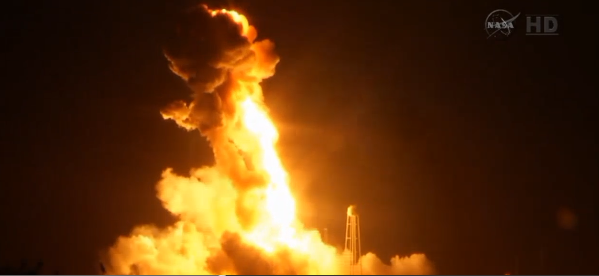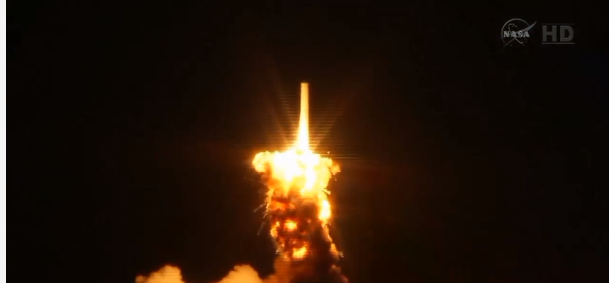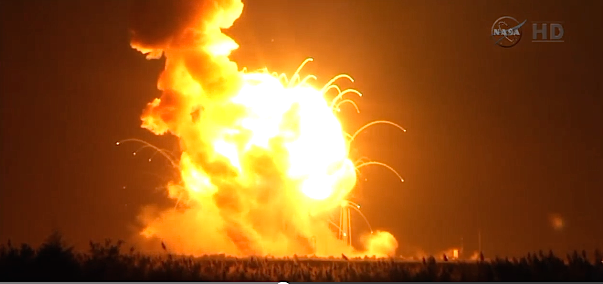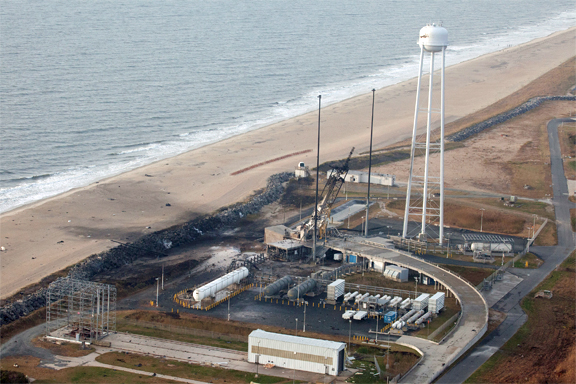[SatNews] An extremely rare and catastrophic incident took place shortly after liftoff on October 28th that resulted in the destruction of the launch vehicle, the payload, and property located at NASA's Wallops Flight Facility in Virgina.
On October 29th, Orbital announced that the company has made progress in forming a permanent Accident Investigation Board (AIB) comprised of company officials, along with representatives from NASA and the NTSB, with the FAA providing overall oversight of the process.
Initially, Mr. Rich Straka, Senior Vice President and Deputy General Manager of Orbital's Launch Systems Group, will serve as the interim chairman to start the investigation process immediately. Additionally, Orbital appointed Mr. Dave Steffy, Senior Vice President and Chief Engineer of the company’s Advanced Programs Group, a highly experienced engineer who is well-versed in launch vehicle engineering and operations, to serve as the permanent chairman of the AIB.

Orbital Sciences Statement
Orbital Sciences Corporation confirms that today’s Antares rocket launch from NASA’s Wallops Flight Facility was not successful. Shortly after lift-off from the Mid-Atlantic Regional Spaceport Pad 0A at 6:22 p.m. (EDT), the vehicle suffered a catastrophic failure. According to NASA’s emergency operations officials, there were no casualties and property damage was limited to the south end of Wallops Island. Orbital has formed an anomaly investigation board, which will work in close coordination with all appropriate government agencies, to determine the cause of today’s mishap.
“It is far too early to know the details of what happened,” said Mr. Frank Culbertson, Orbital’s Executive Vice President and General Manager of its Advanced Programs Group.“As we begin to gather information, our primary concern lies with the ongoing safety and security of those involved in our response and recovery operations. We will conduct a thorough investigation immediately to determine the cause of this failure and what steps can be taken to avoid a repeat of this incident. As soon as we understand the cause we will begin the necessary work to return to flight to support our customers and the nation’s space program.”

Orbital will provide more information as it becomes available and is verified.
The following news is excerpted from Fox News, with some contributions from Associated Press
An unmanned cargo rocket bound for the International Space Station exploded Tuesday over a launchpad in Virginia.
No injuries were reported following the first catastrophic launch in NASA's commercial spaceflight effort.
The accident at Orbital Sciences Corp.'s launch complex at Wallops Island was sure to draw criticism over the space agency's growing reliance on private U.S. companies in this post-shuttle effort.
NASA is paying billions of dollars to Orbital Sciences and the SpaceX company to make station deliveries, and it's counting on SpaceX and Boeing to start flying U.S. astronauts to the orbiting lab as early as 2017. NASA spokesman Rob Navias said there was nothing on the lost flight that was urgently needed by the six people living on the space station.
Orbital Sciences' Antares rocket blew up over the launch complex, just six seconds after the liftoff. The company said everyone at the site had been accounted for, and the damage appeared to be limited to the facilities.

Flames could be seen shooting into the sky as the sun set. There was no hint of any trouble until the rocket exploded. This was the second launch attempt for the mission. Monday evening's try was thwarted by a stray sailboat in the rocket's danger zone. The restrictions are in case of just such an accident that occurred Tuesday.
"We will understand what happened — hopefully soon — and we'll get things back on track," Orbital Sciences' executive vice president Frank Culbertson told his team an hour after the failure. "We've all seen this happen in our business before, and we've all seen the teams recover from this, and we will do the same."
The roomful of engineers and technicians were ordered to maintain all computer data for the ensuing investigation. Culbertson advised his staff not to talk to news reporters and to refrain from speculating among themselves.
"Definitely do not talk outside of our family," said Culbertson, a former astronaut who once served on the space station.

NASA released this aerial photo of damage sustained at the Wallops Island launch facilities on October 29th following Antares rocket explosion.
Image Credit: NASA/Terry Zaperach
This was the fourth Cygnus bound for the orbiting lab; the first flew just over a year ago. SpaceX is scheduled to launch another Dragon supply ship from Cape Canaveral in December.
All the scientists and students behind the science experiments aboard the Cygnus were surely devastated. About one-third of the capsule's contents involved research. Among the instruments that were lost: a meteor tracker and 32 mini research satellites, along with numerous experiments compiled by schoolchildren.
The two Americans, three Russians and one German on the orbiting lab were informed promptly of the accident.
NASA spokesman Rob Navias said there was nothing urgently needed by the space station crew on that flight. In fact, the Russian Space Agency was proceeding with its own supply run on Wednesday.
Orbital has a $1.9 billion contract with NASA to deliver up to 44,000 pounds of cargo to the space station over eight missions through 2016 in the post-space shuttle era, according to Orbital's official website. This launch was Orbital's fourth mission to the space station, the company said.
In addition to the Antares rocket, a two-stage launch vehicle, Orbital's Cygnus spacecraft was carrying 5,050 pounds of supplies, which include science experiments, crew provisions, spare parts and experiment hardware. The mission marked the debut of Orbital's upgraded castor 30XL second-stage motor, which enables greater lift capacity, according to Orbital.
President Obama has long championed this commercial effort, urging that NASA focus its human spaceflight effort less on nearby orbit and more on destinations like asteroids and Mars. He was in Wisconsin for a campaign rally Tuesday evening and was kept abreast of the accident and its developments.
SpaceX's billionaire founder and chief officer Elon Musk — whose company is the face, in many ways, of the commercial effort — said he was sorry to learn about the failure. "Hope they recover soon," he said in a tweet.
Support poured in from elsewhere in the space community late Tuesday night.
"We are with you @OrbitalSciences and @NASA," former NASA astronaut Leland Melvin said via Twitter.
"Very sorry to see the Antares rocket launch failure," said Chris Hadfield, a former Canadian astronaut who served as space station commander last year. "Spaceflight is hard. Very glad that no one was hurt. Now time to sort out why & effects."
John Logdson, former space policy director at George Washington University, said it was unlikely to be a major setback to NASA's commercial space plans. But he noted it could derail Orbital Sciences for a while given the company has just one launch pad and the accident occurred right above it.
"It shows the wisdom of having more than one source" for launches, Logsdon said. Nevertheless, he added, "This is going to put the logistics chain for the station under some stress for a period of time."
U.S. Sen. Bill Nelson, a Florida Democrat who flew on a space shuttle right before the 1986 Challenger disaster, said in a statement, "Space flight is inherently risky. As we push the frontiers of space there will be setbacks. But our commercial space ventures will ultimately be successful."
The explosion also hit Orbital Science's stock, which fell more than 15 percent in after-hours trading.

